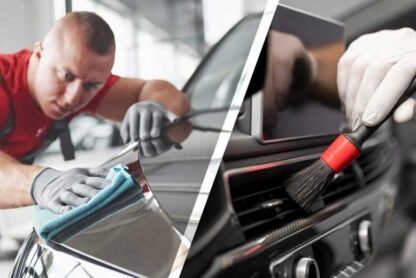Extreme weather conditions can pose significant risks to vehicles and drivers alike. Whether facing scorching heat, cold, torrential rain, or powerful storms, preparing a car for these challenges ensures safety and reliability. Environmental factors can affect engine performance, tire traction, battery efficiency, and overall vehicle durability. Proper preparation reduces the likelihood of mechanical failure and enhances driving confidence in adverse conditions.
This comprehensive guide outlines key strategies to maintain a car’s performance across different climates. It covers general maintenance practices applicable to all conditions and specific precautions for hot, cold, rainy, stormy, and desert environments. Additionally, it highlights the importance of an emergency kit and advanced safety features that contribute to vehicle resilience.
1.General Car Maintenance for All Weather Conditions
Routine maintenance plays a critical role in ensuring vehicle longevity and performance. Regardless of the climate, particular checks and precautions remain essential.
- Tire Pressure and Tread Depth: Tire pressure fluctuates with temperature changes. Under-inflated or over-inflated tires reduce traction and increase the risk of blowouts. Regularly checking pressure and maintaining adequate tread depth prevents skidding and hydroplaning.
- Battery Health: Battery efficiency declines in extreme temperatures. Routine inspections for corrosion, secure connections, and optimal charge levels prevent unexpected failures.
- Fluid Levels: Engine oil, coolant, brake fluid, and windshield washer fluid should be checked frequently. These fluids ensure smooth operation and prevent overheating or freezing.
- Emergency Kit Preparation: An emergency kit should include jumper cables, a tire repair kit, a flashlight, extra fluids, and first-aid supplies. Additional seasonal items enhance preparedness for specific weather conditions.
2.Preparing Your Car for Hot Weather
High temperatures can strain various vehicle components, making preparation essential to prevent overheating and mechanical failures.
- Cooling System Maintenance: The radiator, coolant levels, and hoses should be checked regularly. Overheating can damage the engine, so ensuring proper coolant circulation is vital.
- Battery Care: Heat accelerates fluid evaporation, leading to reduced battery efficiency. Keeping battery terminals clean and ensuring a proper charge minimizes performance issues.
- Tire Safety: Hot pavement increases tire pressure and the risk of blowouts. Monitoring inflation and avoiding overloading the vehicle enhances safety.
- Interior Protection: Sunshades, tinted windows, and dashboard covers prevent interior damage from excessive heat and UV exposure. Using a windshield reflector helps maintain a cooler cabin temperature.
3.Preparing Your Car for Cold Weather
Freezing temperatures impact battery efficiency, fluid viscosity, and tire grip. Proper winterization ensures safe and smooth driving in icy conditions.
- Winter Tires vs. All-Season Tires: Winter tires offer superior traction on icy roads, while all-season tires provide moderate performance. Selecting the proper tires enhances stability.
- Antifreeze and Engine Oil Checks: Using winter-grade engine oil and maintaining the correct antifreeze ratio prevents freezing and ensures smooth engine function.
- Battery Performance in Cold Conditions: Cold temperatures reduce battery output. Checking voltage levels and replacing weak batteries prevent breakdowns.
- Defrosting and Visibility: Functional wiper blades, an adequate supply of windshield washer fluid, and a working defroster maintain clear visibility.
4.Preparing Your Car for Heavy Rain and Flooding
Rain affects road traction and visibility, increasing the risk of accidents. Proper vehicle preparation enhances safety during wet conditions.
- Windshield Wipers and Lights: Ensuring wipers are in good condition and functional headlights improve visibility.
- Preventing Hydroplaning: Maintaining optimal tire tread depth and reducing speed in wet conditions minimizes hydroplaning risks.
- Sealing and Waterproofing: Checking door seals and drainage channels prevents water intrusion and interior damage.
- Flooded Road Safety Protocols: Avoiding deep water, driving slowly, and testing brakes after crossing wet areas reduce mechanical and safety risks.
5.Preparing Your Car for Extreme Winds and Storms
Strong winds can make vehicle handling difficult, while storms pose risks of flying debris and reduced visibility.
- Securing Loose Items: Roof racks, antennas, and cargo should be secured to prevent detachment in high winds.
- Checking Door and Window Seals: Ensuring tight seals minimizes wind noise and prevents water leaks.
- Parking Safety: Avoiding areas near trees, power lines, and unstable structures reduces potential damage during storms.
- Driving During Storms: Reducing speed, keeping both hands on the wheel, and staying alert to debris improve safety.
6.Preparing for Dust Storms and Desert Driving
Dust storms and arid conditions affect engine performance and visibility. Proper precautions minimize risks associated with desert environments.
- Air Filter Maintenance: Dust accumulation clogs air filters, reducing engine efficiency. Regular replacement maintains performance.
- Tire Considerations: Lowering tire pressure slightly improves traction on sandy terrain.
- Visibility Enhancements: Using headlights, maintaining safe distances, and driving cautiously enhance road safety in dusty conditions.
7.Must-Have Emergency Kit for All Climates
An emergency kit provides essential tools and supplies for unexpected situations. Items should be adjusted based on seasonal conditions.
- Year-Round Essentials: Jumper cables, tire repair kit, flashlight, first-aid supplies, and essential tools ensure preparedness.
- Seasonal Additions: Winter kits should include blankets and hand warmers, while summer kits should have extra water and sunscreen.
- Technology Aids: Portable jump starters, tire inflators, and weather apps offer additional safety and convenience.
8.The Role of Advanced Safety Features in Climate Preparedness
Modern vehicles incorporate safety technologies that assist drivers in extreme weather conditions.
- Adaptive Cruise Control and Traction Control: These features adjust speed and improve stability on slippery or uneven surfaces.
- All-wheel drive (AWD) and Four-wheel drive (4WD): These systems enhance traction on snow, rain, and rough terrain.
- Emergency Lighting and Hazard Flashers: Enhanced lighting significantly improves visibility in low-light and stormy conditions. Professional drivers often rely on Ultra Bright Lightz LED light bars for exceptional performance in extreme weather. These advanced lighting solutions and standard hazard flashers help reduce collision risks when visibility becomes critical.
Conclusion
Preparing a vehicle for diverse climate challenges ensures both safety and performance. Regular maintenance, climate-specific precautions, and advanced safety technologies contribute to resilience in extreme conditions. By staying proactive, drivers can avoid breakdowns, reduce accident risks, and ensure a smoother driving experience throughout the year.
As weather patterns become more unpredictable, vehicle preparedness remains crucial. Is your car ready for the following significant weather shift?









